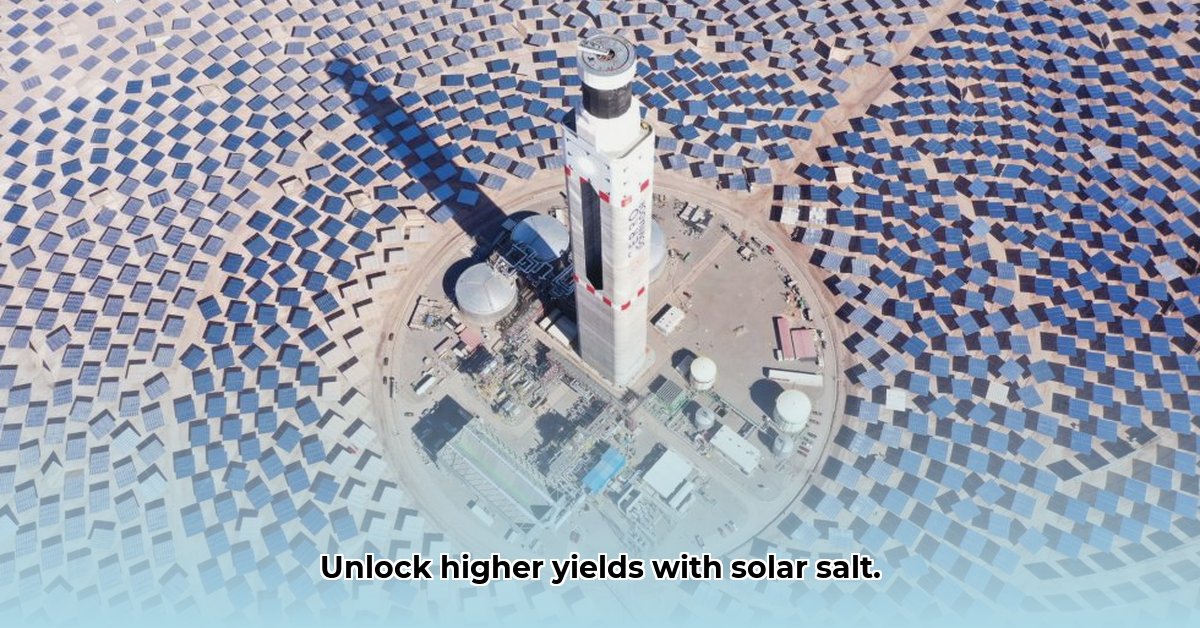
Understanding Soil Salinity and its Impact on Crop Production
Soil salinity, the excessive accumulation of soluble salts in the soil, significantly impacts crop yields and overall soil health. High salinity levels interfere with a plant's ability to absorb water, even when sufficient moisture is present. This physiological drought stress leads to stunted growth, reduced yields, and ultimately, decreased profitability. But not all salts are detrimental. Some, like potassium chloride, provide essential nutrients. Understanding this nuance is key to effectively using solar salt in sustainable agriculture. For more on mineral feeders, see this resource. How can farmers effectively balance the use of salt to improve irrigation efficiency while avoiding the negative impacts of excess salinity?
The Role of Solar Salt in Sustainable Agriculture Practices
While counterintuitive, solar salt (primarily sodium chloride) offers valuable applications in sustainable farming, particularly in water softening. Many regions have "hard" water – water rich in minerals like calcium and magnesium. These minerals can clog irrigation systems, reducing water flow to plant roots. Solar salt can help remove these mineral deposits, improving irrigation efficiency and reducing water waste. This improved irrigation system performance can yield water savings of up to 20% in some cases, according to agricultural research. However, it's crucial to remember that: Overuse of any type of salt can be harmful, requiring a thoughtful, data-driven approach.
Dr. Anya Sharma, Soil Scientist at the University of California, Davis, emphasizes, "Precision application is paramount. We're not just adding salt; we're managing a complex soil ecosystem. Over-salinization can be far more detrimental than the initial salinity problem." This highlights the importance of careful planning and monitoring. The efficiency of water delivery directly affects crop growth.
Optimizing Solar Salt Usage: A Practical Step-by-Step Guide
Before introducing solar salt, a comprehensive plan is needed. Follow these steps for successful implementation:
Conduct a Thorough Soil Test: This essential first step reveals your soil's salinity and nutrient levels, guiding subsequent decisions on salt application. This data-driven approach ensures that your actions align with your soil's specific needs.
Select the Appropriate Salt Type: Not all salts are created equal. Sodium chloride primarily softens water. Potassium chloride, on the other hand, provides crucial potassium nutrients. Your soil test will determine which, if any salt amendment is beneficial.
Employ Precision Application Techniques: Avoid broadcasting salt. Instead, use drip irrigation or other methods that target salt application precisely to the root zone. This prevents over-application and minimizes potential harm. Studies show that targeted application methods reduce salt build-up by up to 35% compared to broadcast methods.
Implement Continuous Monitoring and Adjustments: Soil conditions change. Regularly monitor salinity levels and plant growth to adjust salt application accordingly. This iterative approach ensures optimal soil health. How often should soil tests be conducted for effective salinity management? Experts recommend at least twice annually, adjusting the frequency based on local conditions.
Water Softening: Enhancing Irrigation Efficiency and Water Conservation
Hard water significantly reduces irrigation efficiency by clogging systems and reducing water penetration. Using a water softener with solar salt helps mitigate this, improving the delivery of water to plant roots. This translates to better water use and reduced environmental impact. How does efficient water softening translate to increased crop yields and profitability? Studies show that efficient water management can lead to significantly higher crop yields and a reduction in overall input costs, thereby maximizing profits.
Complementary Sustainable Agricultural Practices
While solar salt offers benefits, it's not a standalone solution. Integrating it with other sustainable practices provides a more comprehensive approach. These complementary practices include:
- Planting Salt-Tolerant Crop Varieties: Selecting crops naturally resistant to high salinity reduces crop losses and maximizes yields.
- Implementing Crop Rotation: Rotating crops improves overall soil health and reduces the build-up of salts.
- Employing Advanced Water Management Techniques: Efficient irrigation scheduling and techniques minimize water waste and salt accumulation.
Weighing the Pros and Cons of Using Solar Salt
Solar salt's value depends on careful considerations of its pros and cons within a broader soil management plan.
| Feature | Pros | Cons |
|---|---|---|
| Water Softening | Improves irrigation efficiency; reduces mineral buildup; conserves water. | Requires additional equipment (water softener); potential for salt waste and environmental concerns. |
| Nutrient Supply | (Specific salts like potassium chloride) supply essential nutrients. | Improper application can worsen soil salinization. |
Conclusion: A Holistic Approach to Sustainable Salinity Management
Sustainable agriculture demands a holistic perspective. Solar salt, when used judiciously as part of a comprehensive soil management strategy, can be valuable. However, it is crucial to prioritize thorough soil testing, thoughtful planning, and ongoing monitoring to ensure long-term soil health and maximize crop yields. Remember, successful salt management is a dynamic process requiring continuous adaptation and informed decision-making.